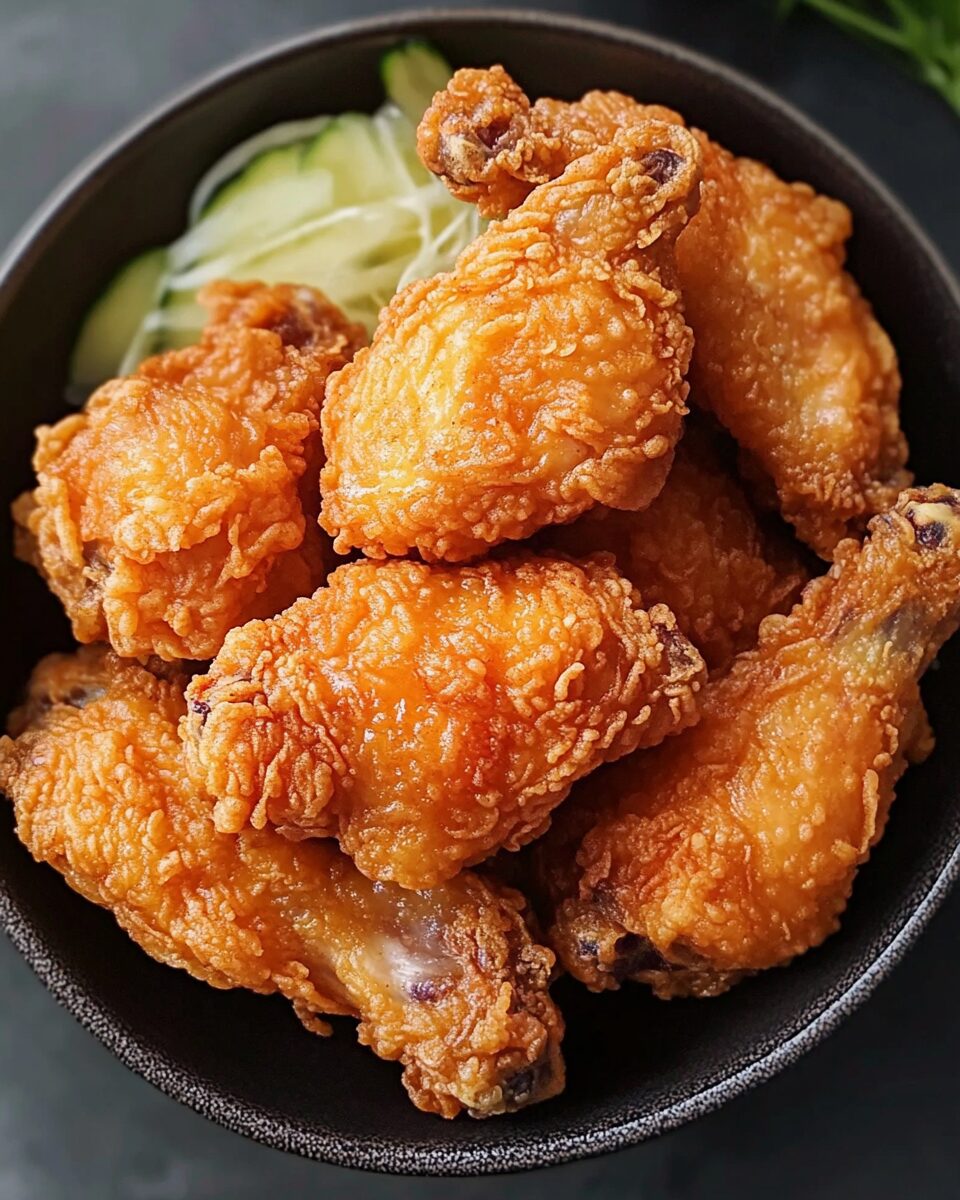Karaage is a popular Japanese fried chicken dish known for its crispy texture and juicy interior. Marinated in a flavorful blend of soy sauce, ginger, and garlic, then coated in a light starch-flour mixture, this dish is deep-fried to golden perfection.
FULL RECIPE:
Ingredients:
- 500g chicken thighs, boneless and skinless, cut into bite-sized pieces
- 2 tablespoons soy sauce
- 2 tablespoons sake (Japanese rice wine)
- 1 tablespoon grated ginger
- 2 cloves garlic, minced
- 1 tablespoon sesame oil
- 1/4 cup potato starch (or cornstarch)
- 1/4 cup all-purpose flour
- Vegetable oil, for frying
- Lemon wedges, for serving
- Optional: Japanese mayo for dipping
Directions:
- In a medium bowl, mix soy sauce, sake, grated ginger, garlic, and sesame oil to make the marinade.
- Add the chicken pieces, ensuring all are coated. Cover and refrigerate for at least 30 minutes, or up to 4 hours.
- In a separate bowl, mix potato starch and all-purpose flour.
- Heat vegetable oil in a deep pan or wok to 170°C (340°F).
- Remove chicken from the marinade and coat each piece in the flour mixture, shaking off excess.
- Fry chicken in batches for 4-5 minutes until golden brown and crispy. Do not overcrowd the pan.
- Drain on paper towels and serve with lemon wedges. Optional: Serve with Japanese mayo for dipping.
Nutrition Facts
- Calories: 290 kcal
- Protein: 22g
-
Total Fat: 18g
- Saturated Fat: 4g
- Cholesterol: 75mg
-
Carbohydrates: 15g
- Dietary Fiber: 1g
- Sugars: 0g
- Sodium: 600mg
- Potassium: 320mg
- Calcium: 15mg
- Iron: 1.5mg
History and Cultural Significance
Karaage, Japan’s famous fried chicken, is a dish deeply embedded in Japanese cuisine. The word “karaage” (唐揚げ) refers to a cooking method where food is lightly coated in flour or starch and deep-fried. While the term can apply to various proteins and even vegetables, it has become synonymous with bite-sized pieces of marinated chicken that are crispy on the outside and tender on the inside. The origins of karaage date back to the Edo period (1603-1868), but its popularity soared in the mid-20th century when Western-style fried foods became more common in Japan.
Why Karaage Stands Out from Other Fried Chicken
Karaage is often compared to Western fried chicken, but there are key differences that make it unique:
- Marination Process – Unlike traditional fried chicken, which often relies on a dry seasoning mix or buttermilk soak, karaage is marinated in a flavorful blend of soy sauce, sake, ginger, and garlic. This enhances the flavor before frying, creating a deeper umami taste.
- Lighter, Crispier Texture – The use of potato starch (or cornstarch) instead of flour results in a thinner, crispier crust that stays crunchy longer.
- Smaller, Bite-Sized Pieces – Karaage is cut into small, manageable pieces before cooking, making it perfect for snacking or eating with chopsticks.
- Healthier Than Western Fried Chicken – Since karaage doesn’t use a heavy batter, it absorbs less oil while frying, making it a relatively lighter option compared to traditional fried chicken.
Serving Suggestions
Karaage is a versatile dish that pairs well with many different sides and sauces. Here are some ways to enjoy it:
- With Rice – A bowl of steamed Japanese rice complements the flavors of karaage, making it a fulfilling meal.
- As a Bento Box Staple – Karaage is commonly packed into bento boxes alongside rice, pickled vegetables, and a small portion of salad.
- With Dipping Sauces – Although delicious on its own, karaage can be served with Japanese mayonnaise, ponzu (citrus soy sauce), or a spicy chili sauce.
- As a Snack or Appetizer – Its crispy, flavorful texture makes it a perfect party snack or appetizer.
- In Karaage Don (Rice Bowl) – Some restaurants serve karaage over rice with a special sauce, turning it into a full meal.
- Paired with Beer or Sake – At Japanese izakayas, karaage is often enjoyed with a cold beer or sake, enhancing the overall dining experience.
Variations of Karaage
Although the traditional recipe is widely loved, there are several regional and creative variations of karaage, each with its own unique twist:
- Shio Karaage (Salt Karaage) – Instead of soy sauce, this version is marinated with salt and sake, offering a lighter, more delicate flavor.
- Zangi (Hokkaido Style) – A specialty of Hokkaido, zangi is a spicier version of karaage, sometimes seasoned with extra garlic and red pepper.
- Tatsutaage – This version uses only potato starch for a lighter, crispier texture and is sometimes flavored with mirin (sweet rice wine).
- Tebasaki (Chicken Wings Karaage) – Instead of using boneless chicken, this variation uses wings, often coated in a sweet and savory glaze after frying.
- Vegan or Tofu Karaage – Some plant-based variations replace chicken with tofu or mushrooms while keeping the same seasonings and frying technique.
Common Mistakes to Avoid When Making Karaage
To achieve the perfect karaage, it’s important to avoid these common pitfalls:
- Skipping the Marination – Marinating the chicken infuses it with flavor, so rushing this step can lead to bland karaage.
- Using Too Much Flour or Starch – A thick coating can make the chicken heavy and less crispy. The goal is to lightly coat each piece for a thin, crunchy texture.
- Overcrowding the Frying Pan – Frying too many pieces at once lowers the oil temperature, leading to soggy, greasy karaage.
- Not Using the Right Oil Temperature – The ideal frying temperature is around 170°C (340°F). Too hot, and the outside burns before the inside cooks. Too low, and the chicken absorbs too much oil.
- Not Draining Properly – Letting karaage sit in oil too long after frying can make it greasy. Use a wire rack or paper towels to remove excess oil.
How to Store and Reheat Karaage
If you have leftovers, here’s how to store and reheat them while maintaining their crispy texture:
- Refrigeration – Store leftover karaage in an airtight container in the refrigerator for up to 3 days.
- Freezing – For longer storage, place karaage in a single layer on a baking sheet, freeze until solid, then transfer to a freezer-safe bag. It will last for up to 1 month.
- Reheating – The best way to reheat karaage is in an oven or air fryer at 180°C (350°F) for about 5-10 minutes. Avoid microwaving, as it will make the chicken soggy.
Health Benefits of Karaage
Although fried food is generally considered indulgent, karaage has some health benefits compared to Western fried chicken:
- High in Protein – Chicken is an excellent source of lean protein, which helps with muscle growth and repair.
- Less Oily than Traditional Fried Chicken – The thin starch coating absorbs less oil, making it a slightly healthier alternative to heavily battered fried chicken.
- Rich in Iron and Vitamins – Chicken thighs contain essential nutrients like iron, zinc, and B vitamins that support overall health.
Conclusion
Japanese Fried Chicken (Karaage) is more than just a delicious dish it represents a perfect balance of flavor, texture, and culinary tradition. Its crispy exterior, juicy interior, and umami-rich marinade make it one of Japan’s most beloved comfort foods. Whether enjoyed as an appetizer, a main course, or even a party snack, karaage is an incredibly versatile dish that appeals to all ages. By following the right techniques, choosing high-quality ingredients, and experimenting with different marinades and coatings, you can create restaurant-quality karaage at home. With its simple preparation and incredible taste, it’s no wonder karaage has gained worldwide popularity.






